

The Swastika
Definitions, Description & Origin
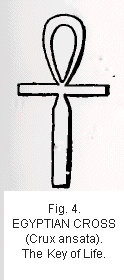 according to Egyptian mytholgy, was Ankh, the emblem of Ka, the spiritual
double of man. It was also said to indicate a union of Osiris and Isis
and was regarded as a symbol of the generative principle of nature.
according to Egyptian mytholgy, was Ankh, the emblem of Ka, the spiritual
double of man. It was also said to indicate a union of Osiris and Isis
and was regarded as a symbol of the generative principle of nature. The Tau cross (fig. 5), so called from it's resemblance to the Greek letter of that name, is of uncertain, though ancient, origin. In Scandinavian mythology it passed under the name of :Thor's hammer," being therein confounded with the Swastika. It was also called St. Anthony's cross for the Egyptian hermit of that name, and was always colored blue. Clarkson says this mark was received by the Mithracists on their foreheads at the time of the initiation. C.W. King, in his work entitled "Early Christian Numismatics" (p.214), expresses the opinion that the Tau cross was placed on the foreheads of men who cry after abominations. (Ezekiel ix, 4.) It is spoken of as a phallic emblem.
Another variety of the cross appeared about the second
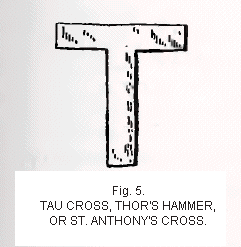 century,
composed of a union of the St. Andrews' cross and the letter P (fig.6),
being the first two letters of the Greek word Christus. This, with another
variety containing all the foregoing letters, passed as the monogram of
Christ (fig.6).
century,
composed of a union of the St. Andrews' cross and the letter P (fig.6),
being the first two letters of the Greek word Christus. This, with another
variety containing all the foregoing letters, passed as the monogram of
Christ (fig.6).As an instrument of execution, the cross, besides being the intersection of two beams with four projection arms, was frequently of compound forms as fig A on which convicted person was fastened by the feet and hung head downward. Another form ,
Fig.7 represents the sign of the military order of the Knights of the Malta. It is of medieval origin.
Fig.8 represents two styles of Celtic crosses. These belong chiefly to Ireland and Scotland, are usually of stone, and frequently set up at marked places on the road sides.
Higgins,
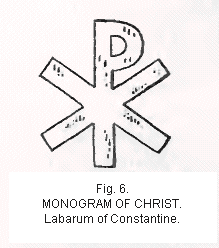 in
his "Anacalypsis," a rare and costly work, almost an encyclopedia
of knowledge (1), says, concerning
the origin of the cross, that the official name of the governor of Tibet,
Lama, comes from the ancient Tibetan word of the cross. The original spelling
was L-a-m-h. This is cited with approval in Davenport's "Aphrodisiacs"
(p.13).
in
his "Anacalypsis," a rare and costly work, almost an encyclopedia
of knowledge (1), says, concerning
the origin of the cross, that the official name of the governor of Tibet,
Lama, comes from the ancient Tibetan word of the cross. The original spelling
was L-a-m-h. This is cited with approval in Davenport's "Aphrodisiacs"
(p.13).Of the many forms of the cross, the Swastika is the most ancient. Despite the theories and speculations of students, its origin is unknown. It began before history, and is properly classed as prehistoric. Its description is as follows: The bars of the normal Swastika (frontispiece and fig.9) are straight, of equal thickness throughout, and cross each other at right angles, making four arms of equal size, length, and style. Their peculiarity is that all the ends are bent at right angles and in the same direction, right, or left. Prof. Max Müller makes the symbol different according as the arms are bent to the right or to the left. That bent to the right, he denominates the true Swastika, that bent to the left he calls Suavastika (fig.10), but he gives no authority for the statement, and the author has been unable to find, except in Burnouf, any justification for a difference of names. Professor Goodyear gives the title of "Meander" to that form of Swastika which bends two or more times. (fig.11).
The Swastika is sometimes represented with dots or points in the corners of the intersections (fig.12a), and occasionally the same when without bent ends (fig.12b), to which Zmigrodzki gives the name of Croix Swasticale.
Some Swastikas have three dots placed equidistant around each of the four ends (fig 12c).
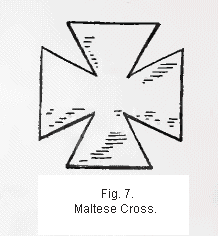
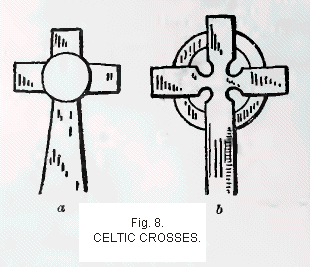
1. Higgins, "Anacalypsis," London 1836, 1,p.230. [Back]
<< Previous Page Next Page >>
© 2004-2007 Northvegr.
Most of the material on this site is in the public domain. However, many people have worked very hard to bring these texts to you so if you do use the work, we would appreciate it if you could give credit to both the Northvegr site and to the individuals who worked to bring you these texts. A small number of texts are copyrighted and cannot be used without the author's permission. Any text that is copyrighted will have a clear notation of such on the main index page for that text. Inquiries can be sent to info@northvegr.org. Northvegr™ and the Northvegr symbol are trademarks and service marks of the Northvegr Foundation.

|